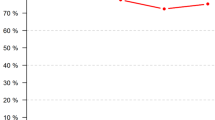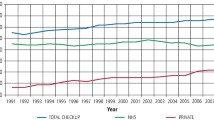Key Points
-
This paper reports a survey of dental hygienist numbers in Canada, Japan, the USA and Western Europe.
-
The results indicate that although the combined populations of Canada, Japan and the USA and the total number of dentists working in these three countries are broadly similar to those in the 18 member states of the European Economic Area (EEA), there are over 15 times as many dental hygienists in the three countries than in the EEA.
-
Fewer than 10,000 dental hygienists worked in EEA member states other than the UK.
-
The potential for the UK to recruit large numbers of hygienists from the EEA is therefore extremely poor.
Abstract
Objective The aims of this study were to establish how many dental hygienists were licensed to practice in Canada, Japan, USA and the 18 member states of the European Economic Area (EEA) and to compare these with the populations and numbers of dentists practising in the countries concerned.
Method Data for the overall populations, numbers of 'active' dentists, of dental hygienists and of employed dental hygienists in the member states of the EEA in 1998 were taken from the responses to a Council of European Chief Dental Officers survey carried out in 2000/2001. Data for these variables for Canada, Japan and the USA in 1998 were accessed from published reports. The ratios of population: active dentist; population: dental hygienist; and active dentist: dental hygienist were calculated and compared.
Results The overall populations and total number of active dentists in the 18 EEA member states and Canada plus Japan plus the USA were broadly similar in 1998 (EEA overall population 381 million with 245,169 active dentists: Canada/Japan/USA overall population 421 million with 253,825 active dentists). However, there were only 13,295 dental hygienists in the EEA as opposed to a total of 215,435 in Canada, Japan and the USA. In terms of population:dental hygienist and active dentist: dental hygienist ratios the UK was found to have proportionally far fewer dental hygienists than Canada, Japan, USA or the four Nordic members of the EEA.
Conclusion The survey revealed that relative to overall populations and numbers of dentists, there are far fewer dental hygienists in the EEA than in Canada, Japan and the USA and that scope for the UK to import dental hygienists from other EEA member states is probably very limited.
Similar content being viewed by others
Main
Since their introduction in the United States of America (USA) some 90 years ago, dental hygienists have made a valuable and growing contribution to oral health in many countries, including the United Kingdom (UK). Recent strategic reviews in both Scotland1 and England2 have recommended the development of the dental team and stressed the role of dental hygienists within the team. The Scottish review1 recommended increasing the numbers of dental hygienist training places, and anecdotal evidence suggests that there are insufficient dental hygienists in the UK. Apart from training more in the UK, it might be possible to recruit dental hygienists from overseas. Those who are citizens of the member states of the European Economic Area (the European Union plus Iceland, Liechtenstein and Norway) and who qualified as dental hygienists at schools within the EEA are permitted to practise in the UK without having to undergo further professional examinations. This exemption does not apply to dental hygienists from countries outside the EEA, who have to 're-qualify' in order to practise in the UK.
Against this background it was decided to carry out a survey of dental hygienist numbers within the EEA and in Canada, Japan and the USA. These three countries were surveyed as they are the only non-European members of the G7 (the most economically 'powerful' countries in the world). The aims of the survey were to establish how many dental hygienists were licensed to practise in the countries surveyed and to compare their numbers with the numbers of dentists in practice and the overall populations of the countries concerned.
Methods
Data for the member states of the EEA were taken from the Council of European Chief Dental Officers (CECDO) survey which was carried out in 2000 and 2001.3,4 In this survey the Chief Dental Officers (or their equivalents) of European countries (including those of the EEA) were asked to report national data for 1998. These data included: national populations, numbers of licensed hygienists, numbers of employed dental hygienists and numbers of 'active' dentists. 'Active' dentists were defined as dentists who were registered and were not retired or working outside their country of registration. For the year 1998, corresponding national data from Canada, Japan and the USA were gathered from published reports.5,6,7 For these three countries 'active dentists' were deemed to be equivalent to dentists reported as employed dentists. Population:dentist, population:dental hygienist and active dentist:dental hygienist ratios were calculated for all the member states and for the three non-European countries.
Results
There were no responses to the CECDO survey from Italy, Liechtenstein, Luxembourg or Spain. These EEA member states had reported data for 1996 in a previous CECDO study and these were included in the totals for EEA member states (Table 1). The total population of the EEA was reported as 381 million of whom over 80% lived in either France, Germany, Italy, Spain or the UK. It was reported that there were 245,169 active dentists and 13,295 registered (enrolled) dental hygienists in the EEA. Six member states (Austria, Belgium, France, Greece, Liechtenstein and Luxembourg) did not train or employ dental hygienists and in Germany they were reported as working in only one federal state (Table 2). Over half (6,953 out of 13,295) of all EEA dental hygienists were reported as registered in either Sweden or the UK. The ratio of population:dental hygienist ranged from 2,774 per hygienist in Sweden to 821,000 per hygienist in Germany with a mean for the EEA of 24,565 per hygienist. The UK was reported as the EEA member state with the highest number of registered hygienists (3,833). However, in terms of the ratio of population:hygienist with 15,566 per hygienist, the UK had comparatively fewer hygienists than Iceland, the Netherlands and the four Nordic Countries (Table 1). Similar results emerged in terms of the ratio of active dentist:dental hygienist, with a range for this variable of from 2.9:1 in Sweden to 620:1 in Germany (EEA mean 18.4:1). The data from the UK yielded an active dentist:dental hygienist ratio of 6.8:1, lower than that for the Netherlands and the four Nordic countries (Table 1). Data for numbers of dental hygienists employed were reported for only seven member states. These data indicated that in six countries, over 80% of registered hygienists were employed as hygienists. However, it was reported that in Norway fewer than 50% (410 out of 907) were actually working as hygienists (Table 1).
Published data for 1998 from the three non-European G7 countries indicated that they had a slightly higher total population than the 18 EEA member states (428 million as opposed to 381 million). In the non-European G7 countries it appears that there were 253,825 dentists (245,169 in the EEA) and 215,435 dental hygienists (13,295 in the EEA) (Table 2 and Fig. 1). Large numbers of dental hygienists were reported as practising in each of the non-European G7. The published data indicated that Canada, the least populous of the three, with a population of just over 30 million, had more hygienists (14,104) than the entire EEA (13,295 for a population of 381 million) (Table 2 and Fig. 1). The population:dental hygienist ratios in all three countries were similar (range 1,946:1 to 2,150:1; mean 1,989:1) as were the active dentist:dental hygienist ratios (range 1:1.1 to 1:1.4; mean 1:1.2). In spite of these large differences in numbers of dental hygienists, the mean population:dentist ratios for the Non-European G7 (1,686:1) and the EEA (1,556:1) were broadly similar (Table 2).
Discussion
The accuracy of some of the data reported in this paper may be questioned on at least two grounds. The first is that 1996 data for four EEA member states were included with 1998 data for the other 14 and for the non-European G7 countries. This approach almost certainly led to an underestimate for the variables of population, numbers of active dentists and numbers of hygienists in the EEA in 1998. Reference to an alternative data source,8 indicated that between 1996 and 1998 the number of registered dentists grew by 1,835 in Italy, 1,356 in Spain and 27 in Luxembourg. It is therefore possible that the figure of 245, 169 for active dentists in the EEA is an underestimate of about 3,000, that is just over 1% of the total. No alternative data source was available for numbers of dental hygienists in Italy and Spain in 1998. A second reason for possible inaccuracy of the data may well be that the numbers of dental hygienists for Germany, Italy, Spain and the USA were estimates. The basis on which these estimates were made for Germany, Italy and Spain is unknown. However, for the USA the data are understood to represent the total number of dental hygienists reported as working in practices throughout the USA, corrected to allow for the fact that some may well have been working in more than one practice (or possibly state).
The somewhat simplistic definition of an active dentist can also be criticised as can the relevance of population: dentist9 and population:dental hygienist ratios as aids to workforce planning. A recent UK survey10 indicated that 12% of women dentists under the age of 65 years were not working and that of those who were, some were working part-time. Both groups were defined as active dentists for the purposes of the current study. Similarly, many dental hygienists in the UK have been shown to take career breaks or to work part-time.11,12,13 It may well be that to some extent these work patterns are common in most if not all of the member states/countries surveyed.
Nevertheless, even allowing for these potential inaccuracies, the data presented in the current study show huge variations in the employment of dental hygienists both between the non-European and European countries of the G7 (France, Germany, Italy and the UK) and within the EEA. As all of the countries/member states included in the survey are economically advanced, a lack of finance in some does not appear to be a factor to explain the disparity. It is also clear that low population:dentist ratios in a country do not necessarily mean that dental hygienists are not employed in that country. In 1998, all of the Nordic EEA member states had population:dentist ratios of less than 1,150:1. and also had the lowest population:dental hygienist ratios in the EEA.4 Whereas EEA member states such as Austria (population:dentist ratio of 2,570:1) and France (1,504:1) neither trained nor employed dental hygienists, the very wide variation in population:dental hygienist ratios between those EEA members states that employed dental hygienists is interesting. In Sweden and to a lesser extent in the other Nordic countries, this ratio was almost similar to that found in the non-European G7 countries. The overall EEA population: dental hygienist ratio was heavily biased by the fact that four of the five most populous members states (France, Germany, Italy and Spain) with a combined population of some 240 million were served by only 1,700 dental hygienists.
Whereas the six EEA members states (Denmark, Finland, Iceland, Netherlands, Norway and Sweden) where, relative to their size, dental hygienists are frequently employed, a combined population of some 39 million was served by some 7,300 dental hygienists, it is interesting to note that, in general, these six members states and the UK have well developed government funded dental services and that all have dentists as Chief Dental Officers who advise their governments. In contrast, dentistry is funded almost entirely privately or through insurance schemes in the six EEA member states (Austria, Belgium, France, Greece, Liechtenstein and Luxembourg) where dental hygienists are not permitted to work and of the six only three have Chief Dental Officers, two of whom are not dentists or clinicians. Such issues may well attract increasing interest as the European Union (EU) develops.
As mentioned in the introduction to this paper, recent strategic reviews have stressed the role of dental hygienists in the dental team in the UK.1,2 It is therefore likely that in the future, efforts will be made to increase the numbers of dental hygienists in the UK. The results of this survey indicate that at present the UK is unlikely to be able to recruit large numbers of dental hygienists from other EEA member states as, in 1998, there were fewer than 10,000 dental hygienists working in the EEA outside the UK. The survey also indicates that in comparison with the non-European G7 countries, the Netherlands and the Nordic members of the EEA, proportionally there are fewer dental hygienist in the UK in terms of population:dental hygienists and active dentist:dental hygienist ratios. It is not within the scope of this paper to consider what may or may not be an appropriate size for the dental hygienist workforce in the UK. The results of this study indicate that to match the relative numbers typical in the Nordic countries, an increase of over 300% would be necessary and to match those in the non-European G7 countries an increase of 700%. It is unlikely that such increases will take place. However, it is important that healthcare planners should be aware of the data.
References
Scottish Executive Health Department. Workforce planning for dentistry in Scotland – a strategic review. Interim report and recommendations. Edinburgh: The Stationery Office, 2000.
Department of Health. NHS Dentistry: Options for Change. London: Department of Health, 2002.
Widström E, Eaton KA, Borutta A . Dybizbánska E, Broukal Z . Oral healthcare in transition in Eastern Europe. Br Dent J 2001; 190: 580–584.
Eaton KA . Factors affecting community oral health care needs and provision. PhD thesis, London: University of London, 2002.
Zillén PÅ, Mindak M . World dental demographics. Int Dent J 2000; 50: 194–197.
Japanese Ministry of Health, Labour and Welfare. Statistics and Information Department Annual Report, 1999. Tokyo: Ministry of Health, Labour and Welfare.
American Dental Association Survey Center. The 1998 survey of dental practice, characteristics of dentists in private practice and their patients 2000. Chicago: American Dental Association.
Eurostat. Statistics on health staff in the European Union 2000. Brussels: European Commission.
Sheiham A . Planning for manpower requirements in dental public health. In Slack G L, Burt B A. Eds. Dental public health: an introduction to community dental health. Bristol: John Wright and Sons, 1981. Chapter 8, pp148–200.
Seward MH . Better opportunities for women dentists – a review of the contribution of women dentists to the workforce, 2001. London: Department of Health.
Hillam DG . Career patterns of dental hygienists qualifying from the Liverpool Dental Hospital School of Dental Hygiene. Br Dent J 1989; 166: 310–311.
Callis PD, Wohlegemuth BG . Career patterns of dental hygienists in Scotland. Br Dent J 2000; 189: 32–34.
Gibbons DE, Corrigan M, Newton JT . A national survey of dental hygienists: working patterns and job satisfaction. Br Dent J 2001; 190: 207–210.
Acknowledgements
The authors wish to thank the members of the Council of European Chief Dental Officers for gathering and reporting the data for EEA member states quoted in this paper and Mr David Gort for his help in preparing the figure.
Author information
Authors and Affiliations
Corresponding author
Additional information
Refereed Paper
Rights and permissions
About this article
Cite this article
Eaton, K., Newman, H. & Widström, E. A survey of dental hygienist numbers in Canada, the European Economic area, Japan and the United States of America in 1998. Br Dent J 195, 595–598 (2003). https://doi.org/10.1038/sj.bdj.4810736
Received:
Accepted:
Published:
Issue Date:
DOI: https://doi.org/10.1038/sj.bdj.4810736
This article is cited by
-
Developing a reliable and valid competency model for assistant dentists in China
BMC Medical Education (2021)
-
The decline in dental caries among Korean children aged 8 and 12 years from 2000 to 2012 focusing SiC Index and DMFT
BMC Oral Health (2016)
-
Will we have enough hygienists?
British Dental Journal (2003)




